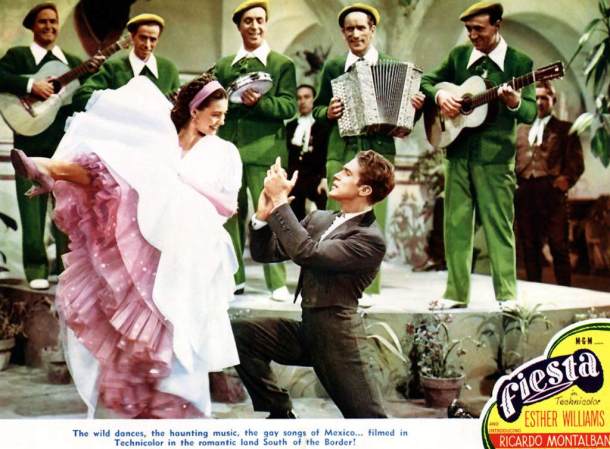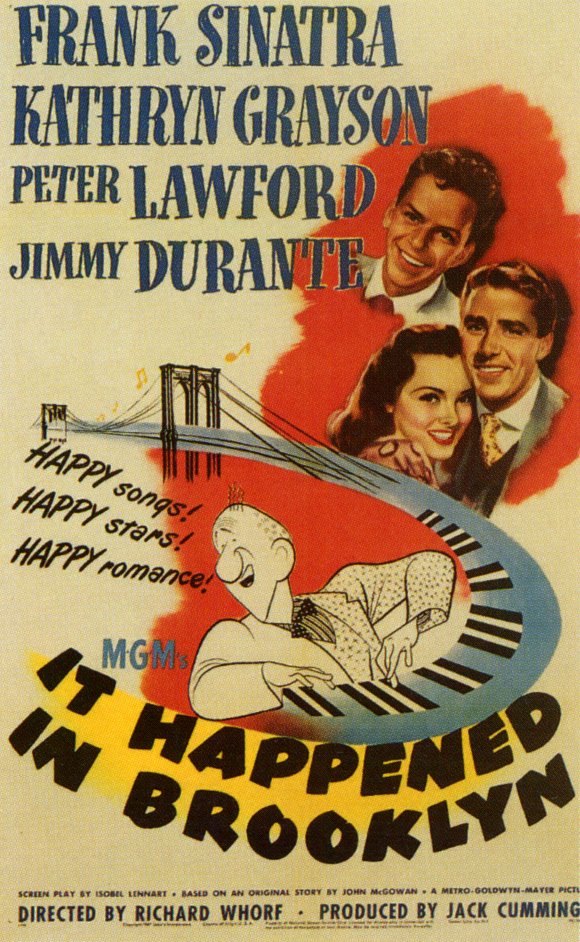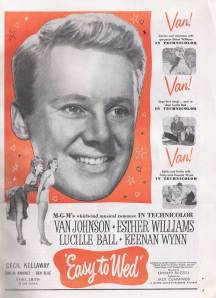 And introducing Ricardo Montalban.
And introducing Ricardo Montalban.
When I sat down to watch Fiesta, those words in the credits floored me. I can’t conceive of what it was like to grow up in a world without Ricardo Montalban. His suave, white-suit-wearing Mr. Roarke, from Fantasy Island (1977-1984), is a mysterious character who was burned into my mind at a young age. Ditto for his insane and weirdly brilliant role as the villain of Star Trek II: The Wrath of Khan (1982). Or his dapper and hilarious bad guy, Vincent Ludwig, in The Naked Gun (1988). Or his work as the pitchman for Maxwell House Decaf.
Maybe it was just the movies and TV shows that I watched, but Montalban seemed ubiquitous.
By the ’80s, he always appeared to be having fun with his “Latin lover” image, but he was never parodying himself. His smooth charm was undeniable, no matter what kind of ridiculous lines were coming out of his mouth. (Like claiming that decaffeinated coffee was “good to the last drop.”)
Richard Thorpe’s Fiesta wasn’t the first film to star Montalban. He’d already appeared in more than a dozen films in his native Mexico. But it was his first Hollywood film, and it was his introduction to American audiences. It was also an opportunity for Esther Williams to perform in a dramatic role that was very different from the roles that had made her famous in MGM’s “aquatic musicals.”
Williams and Montalban play twins, Maria and Mario Morales. Their father, Antonio Morales (Fortunio Bonanova), a former matador, always wanted a son to carry on his work in the ring. After confirming that he is indeed not going to have just a daughter, but rather twins, Morales proclaims his son “The future greatest matador in the whole world!”
Of course, things don’t work out the way Señor Morales expects. His son Mario is a gifted musician and composer who would much rather make music than wear the traje de luces (“suit of lights”) and fight bulls (even though he’s good at it). His daughter Maria, of course, is the one with the real desire to be a torero, but her gender makes such a thing unthinkable.
Mario is torn between his father’s plans for him and the interest that conductor Maximino Contreras (Hugo Haas) shows in his music. Eventually, Mario flees the ring when he finds out his father lied to him about a visit Señor Contreras made to their house. He does so out of anger, but his action is viewed as cowardice by the spectators. Naturally, Maria comes up with a plan to don the traje de luces and impersonate her brother in the ring.
 Fiesta has the kind of shopworn plot and lifeless dialogue that one can suffer through if they’re merely the framework for a musical packed with great songs and exciting dance numbers. But while Fiesta is often classified as a musical, it’s not a really a musical. It’s a turgid, woodenly acted drama whose only high points are a handful of dance sequences.
Fiesta has the kind of shopworn plot and lifeless dialogue that one can suffer through if they’re merely the framework for a musical packed with great songs and exciting dance numbers. But while Fiesta is often classified as a musical, it’s not a really a musical. It’s a turgid, woodenly acted drama whose only high points are a handful of dance sequences.
If you like dancing, then Montalban’s numbers with Cyd Charisse (playing a character named Conchita) are worth seeing. (I especially liked the number they stomped out to “La Bamba,” the traditional Mexican song that Ritchie Valens later made famous.) The scene in which Mario hears one of his compositions played on the radio by Señor Contreras’s orchestra and listens in rapture before sitting down at the piano in the cantina to play along would be at home in a musical, but it’s an organic moment. There are no scenes in Fiesta in which the characters just break into song.
In short, it’s pretty lifeless, especially when compared with other Technicolor extravaganzas from MGM. Most of the cast isn’t very interesting to watch. The great silent star Mary Astor is wasted in a thankless role as Señora Morales. Montalban is enjoyable to watch, but Williams is terribly miscast. It’s not that she doesn’t look “Mexican” (you can see plenty of women who look like Esther Williams if you watch Spanish-language television). It’s that she looks nothing like Montalban, yet the audience is asked to believe that she is a convincing double for him when she dons the traje de luces and enters the ring. Her own stunt double is also a completely unconvincing facsimile of Williams during the bullfighting sequences. His muscular buttocks, lack of breasts, crotch bulge, muscular neck, and big ears are pretty difficult to confuse with Williams’s slightly different attributes.
I like Esther Williams a lot. She’s beautiful and appealing, not to mention a hell of a swimmer. But this was just the wrong role for her. Also, her “romantic” scenes with Jose “Pepe” Ortega (John Carroll) are dead on arrival.
Although the film begins with a statement of sincere thanks to the Mexican people, the production was a troubled one. The cinematographer, Sidney Wagner, and another crew member both died of cholera after eating contaminated street food. Esther Williams’s husband, Ben Gage, and makeup artist George Lane were both expelled from Mexico after a fight with a hotel employee. And a stuntman died of an infection he contracted after being gored in the groin by a bull.
The largest problem the production ran into had to do with bullfighting, which director Thorpe chose to depict in a sanitized fashion. For example, the first time we see Mario’s moves in the ring, he skirmishes with an uninjured bull who charges at him over and over as he dances around the ring and flourishes his cape, avoiding several near misses. Eventually the bull gets too tired to continue, and the fight is over.
During the bullfights in Fiesta, only the bullfighter’s life seems to be in danger. It is presented as a dangerous sport. In reality, the outcome of a bullfight is rarely in question, and it is less a sport than an artistic, ritualized slaughter in which the torero is judged according to his grace and style, not whether or not he kills the bull. (According to this article, which was published last year in The Guardian, only 52 matadors have been killed in the ring since the year 1700. There are myriad injuries, of course, which range from minor to spectacular. If you have a strong stomach, click here.) In Fiesta there are no banderilleros jamming spikes into the bull’s back, bleeding it out and tiring it. There is no taunting of the bull or clownish antics on the part of the other toreadors in the ring, like grabbing the bull’s tail and skiing through the dirt as the bull circles. And, most important of all, there is no killing of the bull with a single sword thrust — the estocada.
Bullfighting is inextricable from the national identity of most Spanish-speaking countries. The people of Mexico were already angry that their own toreadors could not star in the film, so the depiction of bullfighting as a bloodless spectacle added insult to injury. When Thorpe had finished shooting Fiesta, his unit manager Walter Strohm convinced him that the bulls used in the film should all be killed to assuage the anger of the Mexican people. Thorpe acquiesced, even though the bulls had cost $1,000 each, which is nearly $10,000 in today’s dollars.




